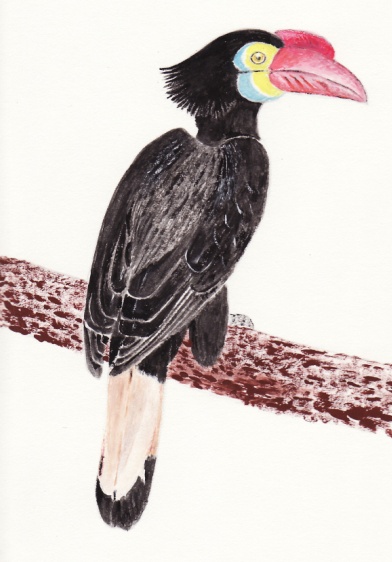Alternative name: Writhe-billed Hornbill; Rufous-headed Hornbill; Panay Wrinkled Hornbill; Visayan Wrinkled Hornbill
- Rhabdotorrhinus waldeni
Identification
60-65 cm (23¾-25½ in)
- Rufous head, neck and upper breast
- Black overall plumage with glossed green upperparts
- Black tail, broad white central band which stains buff through preening
- Red bill and large casque
- Orange bare orbital and gular skin
Female black head, white bare orbital and gular skin tinged with blue, and black underparts and smaller casque.
Distribution

Photo © by Mark Harper
Alegrey Valley, Panay, Philippines, 1 April 2019
Endemic to the central Philippines (Panay, Guimaras and Negros).
A very rare and local restricted-range species. Probably extinct on Guimaras as there is virtually no forest left.
Taxonomy
This is a monotypic species which is sometimes placed in genus Rhyticeros.
May form a superspecies with Writhed Hornbill, Wrinkled Hornbill and Knobbed Hornbill.
Formerly placed in the genus Aceros.
Habitat
Evergreen forest, also in selectively logged forest. Needs larger trees for nesting than Visayan Hornbill.
Occurs up to 950m on Negros and 1200m on Panay.
Behaviour
Diet
Feeds mainly on fruit.
Usually seen in small groups of up to 4 birds, rarely more.
Breeding
Nests in a natural cavity in large trees or in old woodpecker holes. Lays 2 eggs, sometimes 3.
References
- Del Hoyo, J, A Elliot, and J Sargatal, eds. 2001. Handbook of the Birds of the World. Volume 6: Mousebirds to Hornbills. Barcelona: Lynx Edicions. ISBN 978-8487334306
- Clements, J. F., T. S. Schulenberg, M. J. Iliff, D. Roberson, T. A. Fredericks, B. L. Sullivan, and C. L. Wood. 2018. The eBird/Clements checklist of birds of the world: v2018. Downloaded from http://www.birds.cornell.edu/clementschecklist/download/
Recommended Citation
- BirdForum Opus contributors. (2024) Walden's Hornbill. In: BirdForum, the forum for wild birds and birding. Retrieved 25 April 2024 from https://www.birdforum.net/opus/Walden%27s_Hornbill




